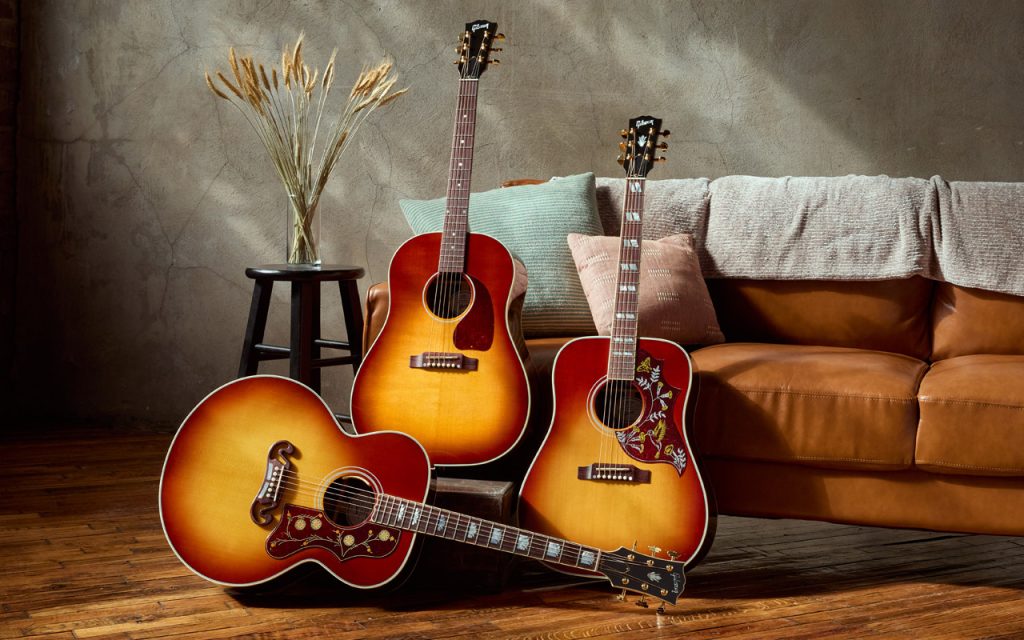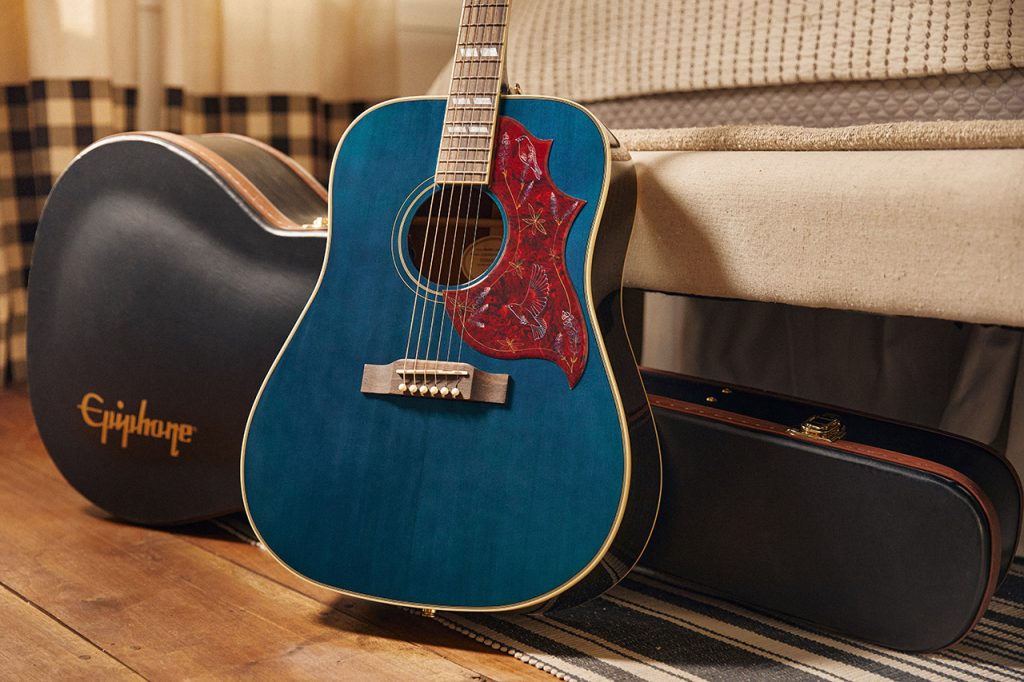To pick up an acoustic guitar for the first time is to see a world of possibilities unfold. Whether you’re a beginner learning to play easy acoustic guitar songs or a stage veteran, the best acoustic guitar brings visions of at-home fun and worldwide fame—of campfire jams and open mic nights.
While that feeling of holding an acoustic guitar is always the same for a guitar player, the feeling of the guitar itself changes. That’s because there are several different acoustic guitar types.
If you’re not familiar with the different acoustic guitar sizes, you’ve come to the right place. We’re exploring the shapes, sizes, and sounds of the most popular acoustic guitar body types.
A Brief Acoustic Guitar Anatomy Lesson
Before we dive into acoustic guitar shapes, it’s worth clarifying some terminology. Just as talking about bodies in medical school would be tough without anatomical knowledge, talking about guitar bodies is a challenge without understanding their structure.
Picture a guitar resting vertically on a stand. From top to bottom, the three most important parts of an acoustic guitar’s body for our discussion are:
- The upper bout – This is the part of the guitar closest to where the neck meets the body. It’s often symmetrical, though some acoustic guitars with cutaways allow you to easily reach the upper frets.
- The waist – This is the narrowest part of the guitar body. In most cases, the soundhole sits in between, or just above, the sides of the waist.
- The lower bout – This is the “bottom” of the guitar and typically its widest point.
Now that you know your anatomy, we can explore the different acoustic guitar types together.

Image: The new Gibson Rosewood Standards
The Impact of a Guitar’s Size and Shape
As you might imagine, guitars are designed differently for specific reasons. The size and shape of an acoustic guitar type, along with the types of acoustic guitar strings used, play a significant role in several ways.
On Sound
First and foremost, size and shape impact the sound of every guitar type.
Think of the inside of an acoustic guitar as a room. The size and shape of a room influence the way sound moves within that room. Clap your hands in your bedroom and then in an empty warehouse, and you’ll hear two distinct sounds.
Well, sound also resonates differently inside of different guitars. Smaller bodies produce brighter, lighter sounds; large bodies are deeper, louder, and more resonant, with more bass.
Of course, other factors also affect a guitar’s sound, including the wood and the guitar player, but that’s a story for another time.
On Playability
Speaking of players, guitar size also impacts how a guitar feels in your hands.
Guitarists with a shorter wingspan may appreciate the feeling of a small-bodied parlor guitar. Taller adults may want all the real estate of a jumbo guitar or instrument, such as the Gibson SJ-200. There’s also the question of instrument weight: If you stand to play, you may prefer a different type–a smaller, lighter guitar.
Shape plays an equal role in playability. If you sit to play, your arm will rest differently on a wide-bottomed jumbo guitar than on a small-bodied instrument.
The best way to get a feel for a guitar is to try it out. But if you can’t make it to the store, this guide is the next best thing. Without further ado, let’s talk acoustic guitar types.

Image: Lil’ Tex Travel Acoustic, Faded Cherry
Small Body Guitars
First up, you have your small-body acoustic guitars. These instruments are larger than a tiny parlor guitar (and far bigger than mandolins) but still smaller than what you might picture as a “typical” acoustic.
Due to their size, smaller acoustic guitars have been at-home staples since their inception. Today, you’ll often see small body acoustics onstage with rock bands because they don’t take up as much “sonic space.”
Characteristics
Small-body guitars tend to have a slim waist and a relatively narrow upper bout. The scale length of a small body guitar (the distance between the nut and the bridge) is sometimes shorter, which makes it easier to move up and down the fretboard.
As such, these smaller guitars are lightweight, portable, and endlessly easy to pick up and play.
Sound Profile
These guitars are known for their sonic clarity and focus. Due to their compact bodies and soundboards (the wood top of the guitar), small-bodied guitars produce notes with less sustain and bass. That said, they still have a warm richness to them.
Smaller guitars also tend to be quieter than their larger counterparts—but that doesn’t mean they disappear in the mix. Well-crafted small-body guitars can still project sound like the best of them.
Examples
To get a feel for small-body guitars, explore some of the best-known Gibson models:
- The L-00 – The Gibson L-00 plays a massive part in the history of small-body guitars. It was described as a guitar with “perfect balance” in the 1934 Gibson catalog, and that accolade still rings true today.
- The LG-2 – With a rich sound that belies its diminutive size, the Gibson LG-2 is ideal for blues, folk, and fingerpicking styles, though it’ll gladly take on any genre.
Round Shoulder Guitars
A round-shoulder guitar is a type of dreadnought-style guitar. (Dreadnought guitars are a larger-bodied style first introduced in 1916.)
Also called slope shoulder guitars, these dreadnought guitar types have the classic silhouette you probably think of when you think of “acoustic guitar.” And that’s in large part thanks to the success of the Gibson J-45™, one of the most iconic acoustic guitars in history.
Characteristics
Round shoulder guitars have a thick waist and a wide, rounded upper bout. The dreadnought guitar body shape is finished by a bulging lower bout that almost forms a triangle with the soundhole as the point.
Sound Profile
A typical round shoulder guitar will sound relatively balanced, with shimmering highs, clean, snappy mids, and a robust low end. You’ll also find these types of dreadnought guitars louder than small-body guitars; you’ll be rewarded with a powerful sound when you play these a little harder.
Examples
Take a look at these Gibson models to familiarize yourself with round-shoulder guitars:
- The J-45 – As Gibson’s best-selling acoustic of all time, the J-45 is truly a legend.
- The J-35 – The lesser-known cousin of the J-45, the Gibson J-35 evolved from the Jumbo in 1936 and carries some of its big brother’s depth and richness.

Image: The Epiphone Miranda Lambert Bluebird Studio
Square Shoulder Guitars
Characteristics
The upper bout of a square shoulder guitar is—you guessed it—more square. Stand a Hummingbird™ on its end, and you could almost balance a drink on it (not that we’d recommend it!).
The waist and lower bout of a square-shoulder guitar are also slightly wider than that of a round-shoulder guitar.
Sound Profile
If round shoulder guitars are warm and “round” sounding, square shoulder instruments deliver more punch and directness. The lows are slightly more booming due to the larger lower bout, while the crisp mids and highs take more of a backseat—without sacrificing tonal clarity.
Examples
Some of the most popular square shoulder models include:
- The Hummingbird – With its gorgeous pickguard and rich sound, the Gibson Hummingbird stands out as one of the ultimate square-shouldered instruments.
- The Dove™ – The Gibson Dove boasts a similar shape, with an ornate bridge and longer scale length.
Square shoulder guitars also fall under the dreadnought category. Similar in size and shape to round-shoulder guitars, they feature a noticeable difference in their silhouette.
Jumbo and Super Jumbo Guitars
Finally, we move on to our last and largest category of acoustic guitar sizes.
As guitarists in the 1930s moved from small parlors to bigger clubs and bars, the need for a louder guitar—one that could keep up with other instruments—became apparent. Enter the jumbo acoustic guitar and super jumbo: Extra-large guitars that take up more space, both visually and sonically.
Characteristics
Jumbo and super jumbo guitars are famous for their oversized bodies. They generally feature a wide, square-ish upper bout—and an even wider lower bout.
Sound Profile
The first thing you’ll notice about the jumbo acoustic guitar is its volume. These large-bodied guitars pack a punch, making them perfect for full band or orchestra settings.
Next, you’ll pick up on the tone. Thanks to their enormous bodies, these guitars have a singing sustain and a more pronounced low end. At the same time, balance is key—the bass doesn’t overpower the mids and treble.
Examples
To see jumbos and super jumbos in action, check out:
- The SJ-200 – The biggest of the big. The Gibson SJ-200 (which stands for Super Jumbo) has a wide lower bout and is known for its deep, resonant tone.
- The J-185 – As a slightly scaled-down version of the SJ, the Gibson J-185 is a more portable jumbo with an unsurpassed balance of lows, mids, and highs.
Choosing the Perfect Fit: Find Your Gibson Guitar
Of course, writing about sound is notoriously challenging. The words “punchy” and “robust” probably mean something different to everyone.
That’s why the best way to decide which acoustic guitar is right for you is to play it. To hear it. To hold it in your hands and feel the excitement.
Whether you gravitate toward the boominess of a Super Jumbo or the high-end charm of a small body model, you’ll find undeniable clarity, richness, and tone in every Gibson guitar you play.
Browse our acoustic guitars today to find your match, then find a dealer near you to get your hands on your next favorite guitar.
Sources:
- MusicRadar. A brief history of the dreadnought acoustic guitar. https://www.musicradar.com/news/guitars/a-brief-history-of-the-dreadnought-acoustic-guitar-637718
- Acoustic Guitar. A Guide to Identifying Common Acoustic Guitar Shapes and Sizes. https://acousticguitar.com/a-guide-to-identifying-common-acoustic-guitar-shapes-and-sizes/

